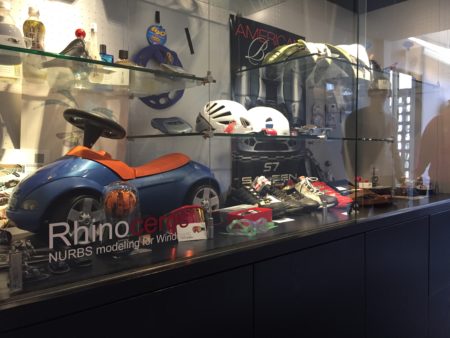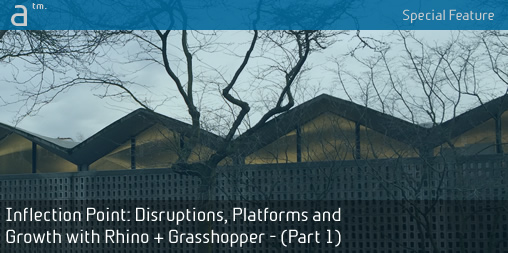Last summer when McNeel & Associates released a commercial version of Rhino 5 for the Mac, a lot of us in the CAD/3D industry were a bit surprised. You see, a WIP (work in progress) version has been in existence for well over five years. It seemed that the WIP might be eternal.
So what changed?
This line of inquiry stayed with me for months when I had the chance to visit the Seattle area for another reason (college hunting for my son). Making a trip over to McNeel & Associates seemed opportune.
Inflection Point? Really?
A commercial release of Rhino for the Mac doesn’t constitute an inflection point for the Seattle-headquartered software leader. But there is more. Things like the future of Grasshopper, the rise of algorithmic computation in the AEC industry, the rise of robots in various industrial sectors—including AEC—and changes in the landscape of software programming models all factor into why visiting McNeel & Associates at this time seemed so timely.
Sitting down with Dan Belcher and Scott Davidson, of McNeel & Associates, pre-college son in tow, we began a conversation that touched on all these points and more. With the rise of algorithmic computation in AEC in particular, I asked them how they felt about being innovators in this movement.
“We wouldn’t call ourselves ‘innovators’,” replies Scott Davidson, who has been with the company for many years. I asked him why not and he replied—”Because we don’t jump on the cutting edge. Yes, you can say that GH [Grasshopper] solves some unique problems but it is not because of some cutting edge technologies. We simply try to solve customers’ problems.”
McNeel (the firm’s full name is Robert McNeel & Associates) is a firm that has rather humble origins, beginning in the early days as an Autodesk dealer. But some might say they are being too humble about being innovators behind the present moment.
Coming of Age—The Visual Scripting Movement in AEC
The truth is McNeel’s Rhino modeling program and visual scripting plugin Grasshopper are arguably the leading actors in a paradigm shift well underway, but with a long way to go, affecting the entire future of the built world.
What makes the McNeel story perhaps more interesting is the vanguard and rebel like nature of both its technology and its orientation as a software firm. While its apps are the actor leads, the firm has had competition—and lately—increased and growing competition. Both Bentley, who was originally in this market early, and Autodesk have similar pairings between powerful parametric 3D modeling and visual, algorithmic scripting tools. And now there are other entrants, like the Nemetschek Group’s Vectorworks subsidiary.

01 – Image is screen shot capture from Vimeo video on 2016 SmartGeometry cluster session titled “Calibrated Modeling of Form-Activated Hybrid Structures” using Rhino, Grasshopper and Kangaroo. Developed by Anders Holden Deleuran (CITA), K2Engineering (Cecillie Brandt-Olsen), GraphViz and NetworkX implemented in GhPython (Giulio Piacentino/Steve Baer). See lower section of article for full video embed.
Looking around globally some of the largest and most avant garde AE firms, places like BIG, Foster & Partners, Nikken Sekkei, Woods Bagot, and Thornton Tomassetti, all have had—often for over a decade—advanced computation groups; and in those groups Rhino and Grasshopper have served prominently at what those groups do. New companies like Flux.io have new web-based visual programming tools that mirror the node-based mode in Grasshopper now popularly seen within the labs at architecture schools around the world.
MORE: Focus: Visiting Nikken Sekkei and Discussing BIM and Graphisoft
Despite this, Scott Davidson wanted to ask, “Do you think this has changed?” when I referred to the idea that Rhino + Grasshopper have the highest mindshare in this sector. Even if it has or may change, it likely doesn’t matter in the grand scheme. McNeel’s Rhino may have started out predominantly in the non-AEC industry but today it remains, with Grasshopper, the phalanx in a toolset transformation that is reshaping AEC from architect to engineer to fabricator to erector.
“Yeah, it has certainly been interesting for us,” admits Davidson modestly about the strong growth the company has experienced in the AEC market. “It is a crazy big market when you add in all the contractors and the subs and Rhino plays well down there.”
“From a market point of view,” adds Davidson “it validates what you are doing…and you know what they say about competition: it’s always a good thing.”
A Global Footprint: Where is Rhino + Grasshopper?
McNeel’s offices are around the world but its main office is headquartered in the lovely Seattle neighborhood of Fremont, where both Google and Tableau have key offices. The architecture style of the famous Seattle Needle, known as “Googie” is also behind the McNeel office’s building, designed by NBBJ. The thin-shell parabolic arched structure is a delightful, though aging, structure the firm has found itself in for decades.
While the vast majority of its programming staff are in Seattle, McNeel has a major office in Barcelona, Spain. Additionally, key support and sales offices are around the world in many countries round with a global staff just under 70 people.

02 – Inside the McNeel offices, a display case showcases some of the real life or prototype products made using Rhino software. Though incredibly popular AEC industry fields now, Rhino is still important in product and industrial design fields.
David Rutten, who is arguably “Mr. Grasshopper”—who created it by himself to solve problems that Rhinoscript could not do—works out of a remote Sound of Music landscape in beautiful Austria. While Rutten invented and single-handedly coded Grasshopper—which staff refer to as GH—these days he is not alone.
“We have more people helping him because it has gotten so big,” added Dan Belcher. “Translating for the Mac, for example…we needed more support that way and there are different people working on various components of GH all around the world. It’s still his baby,” continues Belcher, “but people are doing things that he doesn’t want to do anymore.”
With folks in Spain, Canada, Finland, Asia and other locations in the US, the McNeel footprint continues to expand in concert with its growing user base. And the relationship is unorthodox. “Almost everyone that has started with us over the past 10 years has started somewhere within the Rhino community,” says Belcher. “David was a Rhino community person.”
Programmatic Disruption: Grasshopper and its Future and Present
If Rhino and Grasshopper were a married couple, or Adam and Eve, Rhino would be the Mr and GH the Mrs. Admittedly, while one comes from the other, Grasshopper has a more beautiful user interface and is more evolved. When asked if the two programs would ever share the same look and feel, Davidson answered decisively. “At this point I would say no. It is not important to the community.”
What is important to the community—and what is important to the community ends up having a big impact on what is important to McNeel the software firm—is the development of Grasshopper as a richer programming platform.
“One of the things that became clear with Grasshopper version 1,” says Belcher, “is that it is very much its own development platform. It has its own vernacular and its own language…but it is not an IDE [integrated development environment].” As part of the loftier goals with Grasshopper 2—which is currently in the early stages of development and will be released on both Mac and Windows simultaneously—Rutten wishes for it to be a full-fledged development platform. While it already has an integrated text editor, and while it supports VB, Python and C# (pronounced see-sharp), the goal is to take it much further and for a good reason.
“So one of the things that interest us about Grasshopper is how many ways can you access it?” Belcher adds. “We have a good amount of advanced programmers who want to access it from a variety of ways.”
next page: Grasshopper—Gateway Drug to Programming





Reader Comments
https://t.co/2QkCpB4Aix Very interesting interview with McNeel devs on the present/future of Rhino/Grasshopper. Features our SG pipeline!
RT @ProvingGroundIO: Disruptions, Platforms, and Growth with #Rhino and #Grasshopper https://t.co/zcV8jGtPuf
RT @AHDeleuran: https://t.co/2QkCpB4Aix Very interesting interview with McNeel devs on the present/future of Rhino/Grasshopper. Features ou…
RT @ProvingGroundIO: Disruptions, Platforms, and Growth with #Rhino and #Grasshopper https://t.co/zcV8jGtPuf
Inflection Point: Disruptions, Platforms and Growth with Rhino + Grasshopper (Part 1) | Architosh https://t.co/cNqbX8jlSI via @sharethis
Inflection Point: Disruptions, Platforms and Growth with Rhino + Grasshopper (Part 1) | Architosh https://t.co/cNqbX8jlSI via @sharethis
[…] pagina seguente: Grasshopper-Gateway Drug Programmazione […]
[…] and computation design communities (like SmartGeometry). He says straight away that architects should learn Rhino, Grasshopper and Grasshopper add-ons—like the Galapagos tool we wrote about earlier […]
Comments are closed.